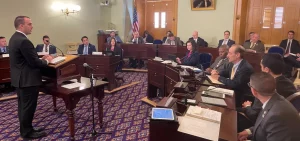News
An Ohio House bill that would cut taxes and cost local governments and schools gets its first hearing
By: Karen Kasler | Statehouse News Bureau
Posted on:
COLUMBUS, Ohio (Statehouse News Bureau) — Lawmakers got their first look at a bill that could create a flat state income tax and make major property tax changes – while potentially costing schools and local governments more than a billion dollars. House Bill 1, sponsored by a newly elected representative, is the top priority of House Speaker Jason Stephens (R-Kitts Hill).

“This legislation empowers our families and businesses to thrive as well as restart Ohio as the economic engine of the Midwest,” said Mathews in his sponsor testimony. He described four goals of the bill: to lower state income taxes to a 2.75% flat tax, to “disentangle our property taxes from our income taxes” to protect homeowners from tax increases now and later, and to “ensure our local communities receive the quality services they expect.”
But Rep. Sean Brennan (D-Parma) said a loss of $1.2 billion will mean “defunding” police and firefighters, K-12 schools, services for children and families, programs for senior citizens, and libraries.
“How do we answer that to those populations that are going to see a cut in services?” Brennan said.
Mathews said he’s reached out to his own city and county officials as he worked on the bill, and said that because of a provision in state law that freezes property taxes and keeps school tax collection flat, the amount of cut is still in the calculation.
“I would hope most of our cities would not use the first 10% of cuts on police and fire,” Mathews said. He added that the bill includes a provision for “using excess funds to help transition from the current enmeshed property tax and income tax system into a more simple and accountable system over the next one, two-ish general assemblies so there is no an instant cut from our local taxing entities.”
Mathews reiterated after the hearing that he thinks the $1.2 billion estimate will be revised down and that property taxpayers won’t be paying more in taxes. And he said wants to hold local governments and school districts harmless, at least for a while.
“There are sections in the legislation where we want to take from our excess fund balance and help them and pay for that, whether that’s a one for one dollar or otherwise to help them now and into the future,” Mathews said.
But Ranking Minority Member Rep. Daniel Troy (D-Willowick) pointed out that efforts to make up what local governments and schools lost to tax changes haven’t lasted long over the years.
Troy also asked why the push to cut taxes now, when there are other issues he said the state should focus its surplus money on, rather than temporarily helping communities recover money lost to this tax cut.
Mathews said the urgency is that “we need people to come here.” He said he returned to Ohio after graduating from law school at Notre Dame because of the good economic climate that exists now, but it’s all “part of the puzzle”.
There is no analysis on House Bill 1 yet from the Legislative Service Commission, the researchers who study bills for state lawmakers. But a report from the left-leaning think tank Policy Matters Ohio shows families making $50,000 a year will get a tax cut of $3 or less, and those making half a million dollars per year could see a tax cut of more than $5,000. The richest 1% in Ohio would get a tax break of more than $11,000.
Troy said after the hearing that’s another thing that bothers him.
“Those 20% highest income earners are going to get 89% of the money. So this does not help those struggling middle class families. They’re not going to get that many dollars,” Troy said. “I’m not advocating raising taxes, but before we cut taxes, we have unmet needs in the the state.”

